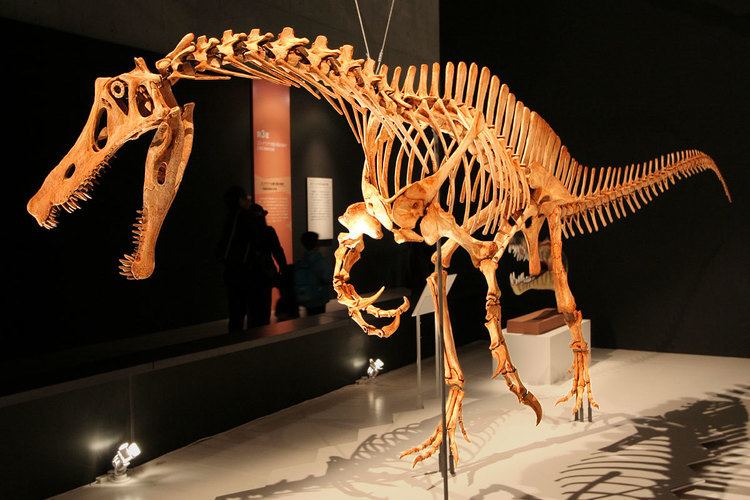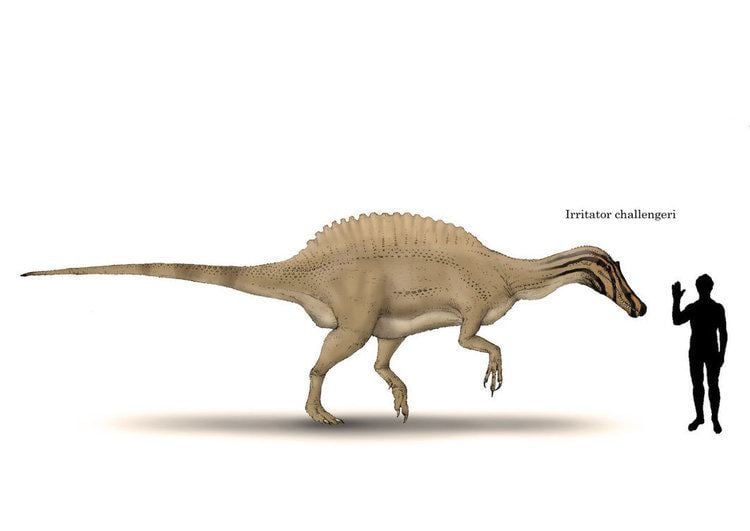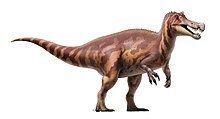Kingdom Animalia Suborder Theropoda Subfamily †Spinosaurinae Higher classification Spinosaurinae Rank Genus | Clade Dinosauria Family †Spinosauridae Scientific name Irritator Phylum Chordata Order Saurischia | |
 | ||
Similar Dinosaur, Suchomimus, Spinosauridae, Baryonyx, Oxalaia | ||
Irritator minisaurs dinosaur animation short
Irritator is a genus of spinosaurid dinosaur that lived in the early Cretaceous Period (Albian stage), around 110 million years ago. Current estimations indicate a length of 8 meters (26 feet). In 2010, Gregory S. Paul gave lower estimations of 7.5 metres and one tonne. It was found in Brazil. Irritator was a theropod with an unusually shaped crest at the rear of its head, and most likely consumed fish.
Contents
- Irritator minisaurs dinosaur animation short
- Description
- Discovery
- Synonymy with Angaturama
- Classification
- Paleobiology
- References

So far the only fossil that has been found was an 80 centimeter long fossil skull in the Romualdo Member, a layer member of the Santana Formation. This skull strongly resembles the skulls of Suchomimus and Spinosaurus. The genus is often regarded today as identical (synonymous) with Angaturama, which lived in the same time and the same place as Irritator.

Description

The holotype fossil consists only of the front part of the head, which is kept today under the number USP GP/2T-5 in the University of São Paulo. It is characterized particularly by its unusual length and curved lip region, which is strongly compressed laterally. The overall length of the complete head is estimated at approximately 84 centimeters. In the premaxilla, a broken-off tooth with partial tooth crown was recovered. The strongly extended and straight teeth with conical tooth crowns, which are 6 to 40 millimeters long, are singly embedded. This indicates continuous tooth replacement where new teeth were pushed up between the old ones. Judging by the tooth sockets, altogether the premaxilla had seven teeth; the third tooth was the largest.
Discovery

Irritator was first scientifically described in 1996 by paleontologists Martill, Cruikshank, Frey, Small and Clarke. Its only known fossil, an 80 cm skull discovered in eastern Brazil, was badly obscured by plaster which was added by the commercial fossil-collecting fossil-poachers who illegally sold it (the trade of fossils is prohibited by law in Brazil), in hopes of making the fossil look more complete and valuable. For example, "the posterior portion of the saggital [sic] crest... [was] fabricated by fossil dealers." The buyers were not aware of the modifications to the illegally collected specimen, and it required them a great deal of work to reconstruct the original features — hence the name. Martill et al. (1996) wrote that the generic name Irritator came "from irritation, the feeling the authors felt (understated here) when discovering that the snout had been artificially elongated." The type species is I. challengeri, which honors the character of Professor Challenger in Arthur Conan Doyle's The Lost World.

The Romualdo Member of the Santana Formation is generally assigned to the Albian and thus the last section of the Early Cretaceous. The layers are aged to approximately 110 million years and to have come from a time in which the continents of Africa and South America were still connected with one another in the northern part of Brazil. The material of I. challengeri, not counting that of A. limai, likely hails from the Romualdo Member of the Santana Formation in Brazil. The holotype is SMNS 58022, from the Stuttgart State Museum of the Natural Sciences, and it consists of an incomplete skull, lacking the anterior (front) portion. The exact discovery site of the Irritator fossil skull is unknown; the fossil was collected by illegal fossil dealers. The skull and the matrix have been assigned to a rock of the Romualdo Member due to lithological characteristic. This classification was confirmed by microfossils of the ostracod Pattersoncypris. Questioning of local fossil dealers resulted in the identification of the discovery site near the village of Buxexé close Santana Do Cariri at the flank of the Chapada do Araripe, at a height of approximately 650 meters. Since rock from the Romualdo Member is indeed exposed there, this discovery site is regarded as very probable for the fossil.
In the year 2004 parts of a spinal column were discovered in the Santana Formation. These have been assigned, due to their structure, to the Spinosauridae. With very high probability these fossils belong to Irritator, since this is the so far the only well-known spinosaurid in the formation.
Synonymy with Angaturama
Angaturama limai, from the same time and place as Irritator challengeri, was described by Kellner and Campos in February 1996 on the basis of a fossil from the Santana Formation. It was named after Angaturama, a protective spirit in the aboriginal Tupi Indian culture of Brazil, and paleontologist Murilo R. de Lima, who informed Kellner of the specimen in 1991. Later research uncovered 60% of the complete skeleton, allowing a replica to be made and mounted for exhibit at the Federal University-owned Rio de Janeiro National Museum. The remains of Angaturama were diagnosed by very strong lateral compression of the snout, and a thin sagittal crest (shape unknown) on top of the premaxilla.
Today, many sources consider Angaturama a synonym of Irritator., owing to the fact that the remains of Angaturama curiously seem to complete Irritator's skull (meaning that they could belong to the same specimen). Kellner and Campos (2000) and Machado and Kellner (2005), however, hold the opinion that the fossils come from two different genera and that Angaturama had a clearly higher and laterally more flattened head than Irritator. If Angaturama and Irritator are actually regarded as a member of the same genus, Irritator challengeri would be the valid scientific name under rules of priority.
Classification
I. challengeri was a member of the Spinosauridae, more specifically the subfamily Spinosaurinae. It shares a close relationship with Spinosaurus and possibly Siamosaurus, though this last genus is not well known from fossil material.
Irritator was originally described as a Maniraptoran within the Tetanurae. It was assigned to the family Baryonychidae, along with Angaturama, Baryonyx, Suchomimus and Spinosaurus by Oliver Rauhut in 2003. Holtz et al. (2004) considered the Baryonychidae synonymous with the family Spinosauridae, and placed these genera within that family. Most later revisions have upheld these classifications.
The following cladogram shows a 2010 analysis of the Megalosauroidea.
Paleobiology
The horizon of the Santana Formation, in which both fossils were found, resulted with very high probability from sedimentation in a flat lake, which was filled with fresh or brackish water. The fossil finds made so far create an ambivalent picture. The fossil insects which have been recovered are an indication for fresh water; the find of the turtle Santanachelys, which was adapted to seawaters, indicate a saltwater environment. One theory is that the site was a brackish lagoon, which was connected to the sea. The climate was tropical and corresponded to today's climate in Brazil to a large extent.
Irritator probably nourished itself on fish, like the pterosaurs found in large number in the Santana Formation. Irritator was probably, like today's crocodiles, a food generalist, eating all other animals that it could catch besides fish. A tooth belonging to Irritator still inserted into a fossil neck vertebral column of a pterosaur, indicates that Irritator ate pterosaurs as well, although it is not known if it actively hunted these animals, or simply scavenged the remains.
All spinosaurids had very narrow jaws with relatively homogeneous pointed teeth. This arrangement is particularly found in crocodiles such as the false gharial. The long conical teeth, which do not possess serrated edges, are suitable particularly to grabbing and holding of prey. They differed from teeth of other theropods, which seemed geared towards tearing or cutting off seized body parts. Particularly with Irritator and Suchomimus a convergence with crocodiles is regularly discussed in the literature. Individual fossils belonging to the Spinosauridae were regarded in the past as crocodile fossils. For example, Baryonyx fossils from Portugal were originally described as Suchosaurus and only in 2007 were they recognized as those of a spinosaurid.
The nostrils of Irritator were shifted far to the rear of the skull, and the secondary palate make respiration possible even if the majority of the jaw was under water or held prey. In particular, the sagittal crest of Irritator is an indication for a pronounced neck musculature, which would have been necessary in order to pull the jaw closed quickly against water resistance and withdraw the head fast. Sues et al. (2002) point out, however, that there would be no reason to assume that the Spinosauridae specialized completely in fishing. They stress rather that this head morphology indicates a generalistic feeding, particularly on small prey animals. In fact, portions of a young Iguanodon, a terrestrial herbivore, were found inside the fossil skeleton of one Baryonyx. Naish et al. (2004) support the theory that Irritator hunted both aquatic and terrestrial animals as a generalist within the coastal area and in addition probably also searched for carrion.
